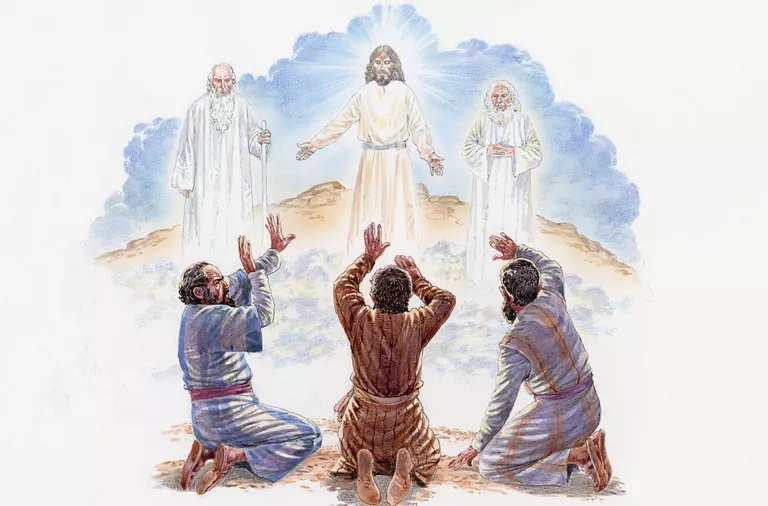Today in the Gospel Reading (Mk 9:2-10) we hear of the Transfiguration of Jesus. Matthew (Mt 17:1 -8) and Luke (Lk 9:28-36) also have accounts of the Transfiguration event, and all three follow the same pattern:
Transfiguration event, and all three follow the same pattern:
- Jesus takes Peter, James and John up a (high) mountain
- There Jesus was transfigured (Mt 17:2 & Mk 9:2) or as Luke record, the ‘appearance’ of Jesus’ ‘face’ changed (Lk 9:29)
- Each record that Jesus’ clothes were ‘dazzling white’
- Moses and Elijah join Jesus and ‘talk’ with him
- Peter offers to build three tents
- A cloud overshadows them
- From the cloud comes a voice saying “This is my Son, the Beloved; listen to Him!” [Matthew adds “with him I am well pleased” (Mt 17:5)]
- The cloud lifts and Jesus is alone.
We are, or should be, familiar with this voice, as we first encountered it at the Baptism of Jesus back in the early stages of each of the synoptics (Mt 3:13-17; Mk 1:9-11; Lk 3:21-22).[1] Here the voice refers to Jesus as Son and Beloved, and in whom voice from heaven was “well pleased”. What we find here is a development in the voice’s instruction that includes: “listen to him!” Clearly as we have advanced through the Jesus story, and our understanding of him has deepened, so must our response to Jesus develop and deepen as well. We must attend to what he says.
Of course, there are many reflections and lines of thought to be taken from the Transfiguration accounts, may I leave you with three.
- The Transfiguration of the Lord reminds us that just as the disciples’ understanding and appreciation of Jesus grew and developed, so must as ours. In some ways, at times, I feel we are a little short-changed in our understanding and appreciation of Jesus, because we know the whole story, and the ‘surprise’ element that must have been the experience of the disciples as they came to know Jesus we are somewhat ‘robbed’ of. Conversely, our knowing the story from beginning to end as we progressively read through the Gospels should allow us to have a certain anticipation as we say to ourselves: “We know what’s happening next!”. Whatever our circumstance – all knowing, or responding to surprise – our relationship with the Risen needs to grow and develop.
- The Transfiguration of the Lord reminds us of the divinity of Jesus. Jesus is (much) more than ‘our mate’, much more than someone who articulated the good way of living. We must be drawn to more than the ‘Jesus project’. The God of Universe breaks into the human history in an unprecedented way in the life of Jesus. The ‘friendship’ we come to know in Jesus is a ‘friendship’ with the Holy (Holiest) One, and so we should embrace it, but with a certain reverential fear and awe. Jesus was not just a ‘nice bloke’!
- Peter, James and John’s experience of the Divine in the Transfiguration of the Lord can be likened to our experiences of God. Perhaps these experiences, these rich moments of insights (mountains experiences one could say), are not long lingering, but that grab us for moment and then are gone; the result of the experience colouring the rest of our days. Whilst we might want to grab hold of and keep these moments – build a tent – often the nature of our experience is that this is not an option for us. So, let us savour these moments, so that when we come down from the mountain, the plain on which we live is transformed.
[1] John’s Gospel has its own recount of the Baptism of Jesus (Jn 1:29-34) but its focus/nuance is different, for example, we find a reference to the Spirit descending on Jesus but no mention a voice.
Image downloaded from https://www.learnreligions.com/transfiguration-bible-story-summary-700068 on 03 August, 2021.